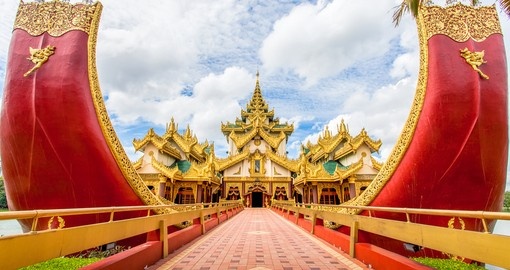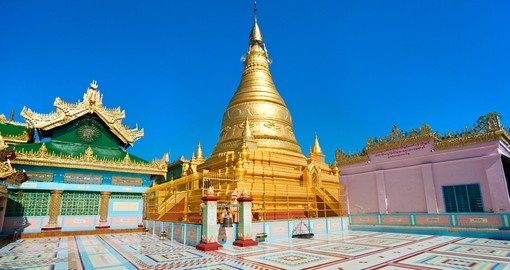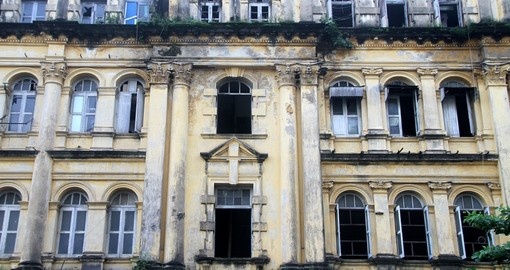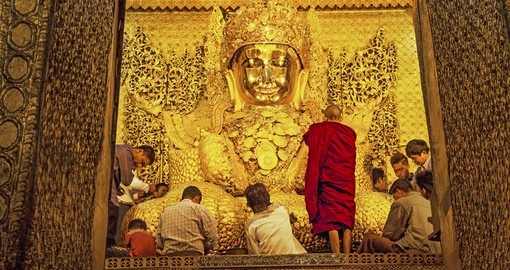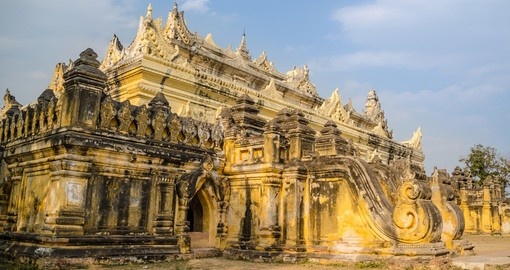Myanmar History
Evidence of the first humans in Myanmar dates back as early as 11,000 years ago, however, the first identifiable civilization, the Mon, dates to around 3,000 BC. By 300 BC the first kingdom was established in Thaton. A mixture of Mon and Indian culture emerged and by the 9th century AD, the Mon had come to dominate all of southern Myanmar. By the 14th century, art and culture began to reemerge and this time is considered the great age of Burmese literature. Myanmar entered a golden age and became a centre of commerce and of Theravada Buddhism.
Despite becoming a popular trading centre that attracted international interests, internally, Myanmar was facing intense wars which led to divisions and rebellions and finally the establishment of different kingdoms. These kingdoms eventually fell in 1752 and by 1753, under a popular Burmese leader Alaungpaya, many outside forces were expelled from northern Myanmar. Alaungpaya’s son went on to conquer Ayutthaya which led the Chinese to take notice. Myanmar was able to repel four different Chinese invasions between 1766-69.
In January 1824, a Burmese general, Maha Bandula, led forces that were successful in conquering Assam - a northeastern state in India. This brought Myanmar face-to-face with British interest in India. Britain began to worry about Myanmar’s continued conquests and this led to three Anglo-Burmese wars between 1824-1885 resulting in Britain making Myanmar a province of India in 1886. This signalled the end of the monarchy and the separation of church and state. Also, with a growing economy, the majority of the proceeds went to the British while the Burmese population hardly saw any of it.
The 20th century began with a desire for independence. What began as a peaceful protest led by the educated population turned into a peasant protest and a strike in 1936. Britain responded by separating Myanmar from India in 1937 and granted the country colony status. After the Second World War, a new independence movement led by Aung San who is considered to be the father of modern Burma/Myanmar emerged. Aung San was pivotal in Myanmar gaining independence in 1948, however, he was assassinated that same year.
In 1962, General Ne Win led a left-wing army takeover in an attempt to lead Myanmar to socialism by nationalizing everything. This essentially crippled the economy and by 1987, the people had reached their boiling point. They took to the streets to protest which resulted in confrontations with the military. There were 3,000 deaths in only six weeks. General Ne Win was ousted in 1988 but still welded some behind-the-scenes power.
The government declared martial law and promised to hold elections in May 1989. An opposition group began to emerge led by Aung San Suu Kyi (daughter of Aung San) called the National League for Democracy (NLD). During this time, the government changed the name of the country from Burma to Myanmar as Burma was a constant reminder of European colonization. As the NLD gained support, Aung San Suu Kyi was put under house arrest. Despite this, the NLD won the majority of the vote but were prevented from taking their parliamentary seats. Aung San Suu Kyi was awarded the Nobel Peace Prize in 1991and was released from house arrest in 1995. She was arrested two more times and was released in 2010. In May 2012, Aung San Suu Kyi entered the lower house of parliament as an MP.
Despite an election in 2010 that the UN and many western countries deemed fraudulent, the government in Myanmar is beginning to set new reforms in place moving toward liberal democracy. Dialogue has begun with other countries and 2011 saw Hillary Clinton, US Secretary of State visit - the first time a Secretary of State has visited in fifty years. This has hopefully signalled the beginning of the end of isolation for Myanmar.
The Irrawaddy Flotilla Company (IFC)
The story of the IFC is embedded in the history of Myanmar (Burma). In the second Anglo-Burmese War of 1852, the British transferred from India steam paddle ships of the Bengal Marine to transport troops on the Irrawaddy. They were officered by the British and crewed by Bengal lascars. The expedition force flotilla advanced rapidly up the river - further than they originally intended.
In 1864 the Governor of British Burma decided to privatize the flotilla. A Scottish firm based in Rangoon (Yangon) purchased 4 steamers and 3 flats. Merging with a shipping line and a Scottish shipbuilder with expertise in shallow draft paddle technology.
In 1885 the Irrawaddy Flotilla was requisitioned to carry troops again in another river war. The force was so organized that the war was near bloodless as the flotilla proceeded to Mandalay where, without struggle, the King capitulated.
Trade flowed freely and Burma rapidly grew to become one of the richest lands in Asia. Rangoon was the pearl of the Orient. In 1943 economic success was intertwined with the operations and activities of the IFC.
In 1942 before the advance of the Imperial Japanese Army, the company's own officers gunned holes in 600 ship's hulls rather than let them fall into enemy hands. It was called "an act of denial".
Pandaw, a river boat company, has inherited the name (IFC) and today claims to work daily to revive the pioneering can-do spirit of their Scottish forefathers. Pandaw has grown over the last 20 years to be one of the most significant river cruise operators in Asia. Visit Goway's Pandaw Cruises.
Myanmar Travel Information
At Goway we believe that a well-informed traveller is a safer traveller. With this in mind, we have compiled an easy-to-navigate travel information section dedicated to Myanmar.
Learn about the history and culture of Myanmar, the must-try food and drink, and what to pack in your suitcase. Read about Myanmar's nature and wildlife, weather and geography, along with 'Country Quickfacts' compiled by our travel experts. Our globetrotting tips, as well as our visa and health information, will help ensure you're properly prepared for a safe and enjoyable trip. The only way you could possibly learn more is by embarking on your journey and discovering Myanmar for yourself. Start exploring… book one of our Myanmar tours today!
Extend Your Trip
After your Myanmar tour considers taking the time to visit other destinations. Goway offers exciting China vacation packages, India tours and Thailand vacation packages plus a comprehensive selection of vacation packages in many other Asian countries.
Book your Myanmar tour with Goway!
 ASIA by Goway is an exclusive division that specializes in planning and organizing Myanmar tours and experiences. Choose from a small group tour, a cruise through the heart of Myanmar, an independent travel module, and much more. We want to be your first choice when next you go globetrotting to Myanmar.
ASIA by Goway is an exclusive division that specializes in planning and organizing Myanmar tours and experiences. Choose from a small group tour, a cruise through the heart of Myanmar, an independent travel module, and much more. We want to be your first choice when next you go globetrotting to Myanmar.
Get a Trip Quote Order a Brochure






